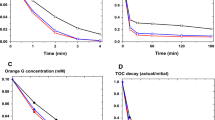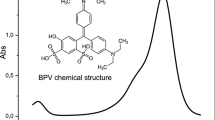Abstract
Visible light irradiation combined with homogeneous iron and/or hydrogen peroxide to degrade organic dye rhodamine B (RhB) and small molecular compound 2,4-dichlorophenol (2,4-DCP) in a home-made bottle reactor was assessed. The concentration of oxidize species, Fe3+ and Fe2+ were determined during the degradation process. The results demonstrated that visible light irradiation combined with electro-Fenton improved the degradation efficiency. Moreover, both RhB and 2,4-DCP were mineralized during visible light synergistic electro-Fenton oxidation process. 95.0% TOC (total organic carbon) removal rate of RhB occurred after 90 min and 96.7% of COD (chemical oxygen demand) removal rate after 65 min of irradiation. 91.3% TOC removal rate of 2,4-DCP occurred after 16 h of irradiation and 99.9% COD removal rate occurred after 12 h of illumination. The degradation and oxidation process was dominated by the hydroxyl radical (·OH) generated in the system. Both the impressed electricity and dye sensitization by visible light facilitated the conversion between Fe3+ and Fe2+, thus, improving Fenton reaction efficiency.
Similar content being viewed by others
References
Neumann GT, Hicks JC. Novel hierarchical cerium-incorporated MFI zeolite catalysts for the catalytic fast pyrolysis of lignocellulosic biomass. ACS Catal, 2012, 2: 642–646
Panizza M, Cerisola G. Electrocatalytic materials for the electrochemical oxidation of synthetic dyes. Appl Catal B: Environ, 2007, 29: 95–101
Tuan PA, Sillanpää M. Effect of freeze/thaw conditions, polyelectro lyte addition, and sludge loading on sludge electro-dewatering process. Chem Eng J, 2010, 164: 85–91
Tokumura M, Ohta A, Znad HT, Kawase Y. UV light assisted decolorization of dark brown colored coffee effluent by photo-Fenton reaction. Water Res, 2006, 40: 3775–3781
Garcia-Segura S, Almeida LC, Bocchi N, Brillas N. Solar photoelectro-Fenton degradation of paracetamol using a flow plant with a Pt/air-diffusion cell coupled with a compound parabolic collector: Process optimization by response surface methodology. J Hazard Mater, 2011, 194: 109–118
Masomboon N, Ratanatamskul C, Lu MC. Chemical oxidation of 2,6-dimethylaniline by electrochemically generated Fenton’s reagent. J Hazard Mater, 2010, 176: 92–98
Justino C, Marques AG, Rodrigues D, Silva L, Duarte AC, Rocha-Santos T, Freitas AC. Evaluation of tertiary treatment by fungi, enzymatic and photo-Fenton oxidation on the removal of phenols from a kraft pulp mill effluent: A comparative study. Biodegradation, 2011, 22: 267–274
Chan KH, Chu W. Model applications and intermediates quantification of atrazine degradation by UV-enhanced fenton process. J Agric Food Chem, 2006, 54: 1804–1813
He J, Ma WH, He JJ, Zhao JC, Yu JC. Photooxidation of azo dye in aqueous dispersions of H2O2/α-FeOOH. Appl Catal B: Environ, 2002, 39: 211–220
Feng JY, Hu XJ, Yue PL. Novel bentonite clay-based Fe-nanocomposite as a heterogeneous catalyst for photo-fenton discoloration and mineralization of orange II. Environ Sci Technol, 2004, 38: 269–275
Wang SL, Fang YF, Yang Y, Liu JZ, Deng AP, Zhao XR, Huang YP. Catalysis of organic pollutant photodegradation by metal phthalocyanines immobilized on TiO2@SiO2. Chin Sci Bull, 2011, 56: 969–976
Yang J, Chen DX, Deng AP, Fang YF, Luo GF, Li DJ, Li RP, Huang YP. Visible light-induced N-doped TiO2 nanoparticles for the degradation of microcystin-LR. Sci China Chem, 2010, 53: 1793–1800
Selvam K, Murugan M, Swaminathan M. Enhanced heterogeneous ferrioxalate photo-Fenton degradation of reactive orange 4 by solar light. Sol Energy Mater Sol Cells, 2005, 89: 61–74
Kurt U, Apaydin O, Gonullu MT. Reduction of COD in wastewater from an organized tannery industrial region by Electro-Fenton process. J Hazard Mater, 2007, 143: 33–40
Brillas E, Sires I, Oturan MA. Electro-Fenton process and related electrochemical technologies based on Fenton’s reaction Chemistry. Chem Rev, 2009, 109: 6570–6631
Gogate PR, Pandit AB. A review of imperative technologies for wastewater treatment I: oxidation technologies at ambient conditions. Adv Environ Res, 2004, 8: 501–551
Sires I, Centellas F, Garrido JA, Rodriguez RM, Arias C, Cabot PL, Brillas E. Mineralization of clofibric acid by electrochemical advanced oxidation processes using a boron-doped diamond anode and Fe2+ and UVA light as catalysts. Appl Catal B: Environ, 2007, 72: 373–381
Brillas E, Calpe JC, Casado J. Mineralization of 2,4-D by advanced electrochemical oxidation processes. Water Res, 2000, 34: 2253–2262
Brillas E, Mur E, Sauleda R, Sànchez L, Peral J, Domènech X, Casado J. Aniline mineralization by AOP’s: anodic oxidation, photocatalysis, electro-Fenton and photoelectro-Fenton processes. Appl Catal B: Environ, 1998, 16: 31–42.
Flox C, Ammar S, Arias C, Brillas E, Vargas-Zavala AV, Abdelhedi R. Electro-Fenton and photoelectro-Fenton degradation of indigo carmine in acidic aqueous medium. Appl Catal B: Environ, 2006, 67: 93–104
Flox C, Cabot P, Centellas F, Garrido JA, Rodríguez RM, Arias C, Brillas E. Solar photoelectro-Fenton degradation of cresols using a flow reactor with a boron-doped diamond anode. Appl Catal B: Environ, 2007, 75: 17–28
Malato S, Blanco J, Alarcon DC, Maldonado MI, Fernandez-Ibanez; Gernjak W. Photocatalytic decontamination and disinfection of water with solar collectors. Catal Today, 2007, 122: 137–149
Munaf E, Zein R, Kurniadi I. The use of rice husk for removal of phenol from wastewater as studied using 4-aminoantipyrine spectrophotometric method. Environ Technol, 1997, 18: 355–358
Song W J, Ma W H, Ma J H, Chen CC, Zhao JC. Photochemical oscillation of Fe(II)/Fe(III) induced by periodic flux of dissolved organic matter. Environ Sci Technol, 2005, 39: 3121–3127
Ishibashi K, Fujishima A, Watanabe T, Hashimoto K. Detection of active oxidative species in TiO2 photocatalysis using the fluorescence technique. Electrochem Commun, 2000, 2: 207–210
Bader H, Sturzenegger V, Hoigne J. Photometric method for the determination of low concentrations of hydrogen peroxide by the peroxidase catalyzed oxidation of N,N-diethyl-p-phenylenediamine (DPD). Water Res, 1988, 22: 1109–1115
Huang YP, Liu DF, Zhang SY, Zhang DL, Ma WH, Zhao JC. Fenton photocatalytic degradation of organic dye under visible irradiation. Chem J Chinese Univ, 2005, 26: 2273–2278
Sires I, Arias C, Cabot PL, Centellas F, Garrido JA, Rodríguez RM, Brillas E. Degradation of clofibric acid in acidic aqueous medium by electro-Fenton and photoelectro-Fenton. Chemosphere, 2007, 66: 1660–1669
Song W J, Chen C C, Ma J H, Ma WH, Tang YL, Zhao JC, Huang YP, Xu YM, Zang L. Decomposition of hydrogen peroxide driven by photochemical cycling of iron species in clay. Environ Sci Technol, 2006, 40: 618–624
Author information
Authors and Affiliations
Corresponding author
Rights and permissions
About this article
Cite this article
Wang, S., Wang, Q., Fang, Y. et al. Degradation of organic pollutants by visible light synergistic electro-Fenton oxidation process. Sci. China Chem. 56, 813–820 (2013). https://doi.org/10.1007/s11426-012-4809-1
Received:
Accepted:
Published:
Issue Date:
DOI: https://doi.org/10.1007/s11426-012-4809-1




